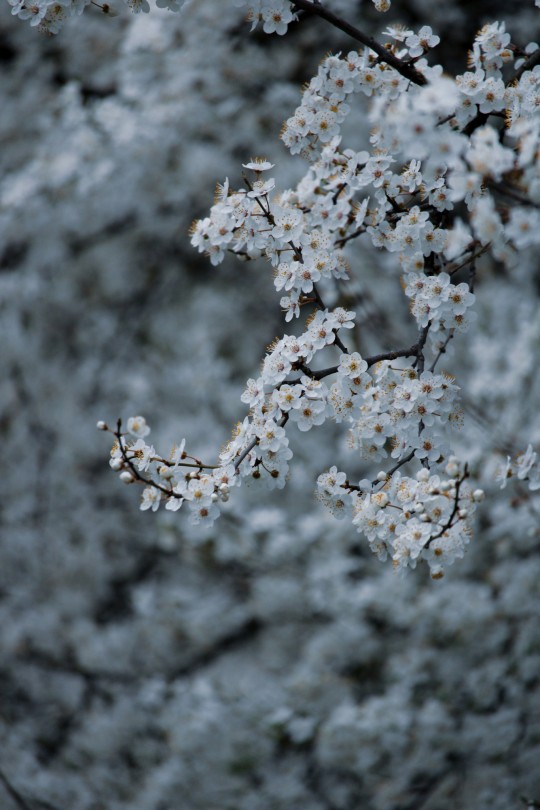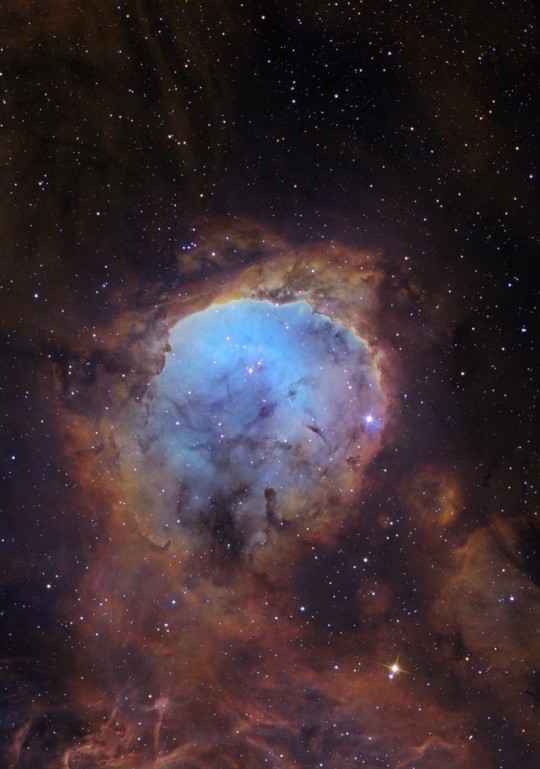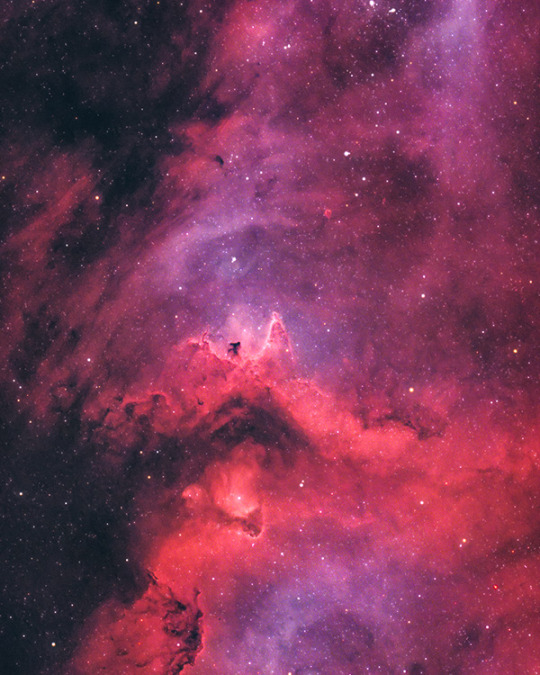Text
0 notes
Photo
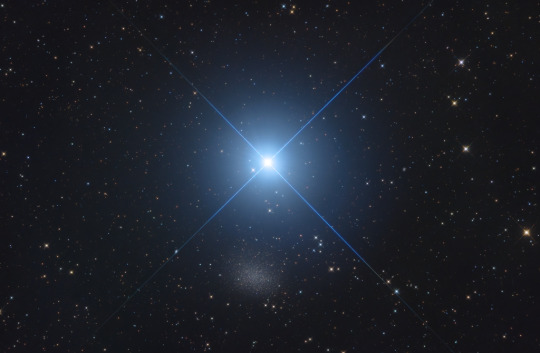
2024 April 26
Regulus and the Dwarf Galaxy
Image Credit & Copyright: Markus Horn
Explanation: In northern hemisphere spring, bright star Regulus is easy to spot above the eastern horizon. The alpha star of the constellation Leo, Regulus is the spiky star centered in this telescopic field of view. A mere 79 light-years distant, Regulus is a hot, rapidly spinning star that is known to be part of a multiple star system. Not quite lost in the glare, the fuzzy patch just below Regulus is diffuse starlight from small galaxy Leo I. Leo I is a dwarf spheroidal galaxy, a member of the Local Group of galaxies dominated by our Milky Way Galaxy and the Andromeda Galaxy (M31). About 800 thousand light-years away, Leo I is thought to be the most distant of the known small satellite galaxies orbiting the Milky Way. But dwarf galaxy Leo I has shown evidence of a supermassive black hole at its center, comparable in mass to the black hole at the center of the Milky Way.
∞ Source: apod.nasa.gov/apod/ap240426.html
81 notes
·
View notes
Photo

2024 April 25
NGC 604: Giant Stellar Nursery
Image Credit: NASA, ESA, CSA, STScI
Explanation: Located some 3 million light-years away in the arms of nearby spiral galaxy M33, giant stellar nursery NGC 604 is about 1,300 light-years across. That’s nearly 100 times the size of the Milky Way’s Orion Nebula, the closest large star forming region to planet Earth. In fact, among the star forming regions within the Local Group of galaxies, NGC 604 is second in size only to 30 Doradus, also known as the Tarantula Nebula in the Large Magellanic Cloud. Cavernous bubbles and cavities in NGC 604 fill this stunning infrared image from the James Webb Space Telescope’s NIRCam. They are carved out by energetic stellar winds from the region’s more than 200 hot, massive, young stars, all still in early stages of their lives.
∞ Source: apod.nasa.gov/apod/ap240425.html
68 notes
·
View notes
Photo

2024 April 24
Dragon’s Egg Bipolar Emission Nebula
Image Credit & Copyright: Rowan Prangley
Explanation: How did a star form this beautiful nebula? In the middle of emission nebula NGC 6164 is an unusually massive star. The central star has been compared to an oyster’s pearl and an egg protected by the mythical sky dragons of Ara. The star, visible in the center of the featured image and catalogued as HD 148937, is so hot that the ultraviolet light it emits heats up gas that surrounds it. That gas was likely thrown off from the star previously, possibly the result of a gravitational interaction with a looping stellar companion. Expelled material might have been channeled by the magnetic field of the massive star, in all creating the symmetric shape of the bipolar nebula. NGC 6164 spans about four light years and is located about 3,600 light years away toward the southern constellation Norma.
∞ Source: apod.nasa.gov/apod/ap240424.html
108 notes
·
View notes
Photo

2024 April 23
Contrail Shadow X
Image Credit & Copyright: Fatih Ekmen
Explanation: What created this giant X in the clouds? It was the shadow of contrails. When airplanes fly, humid engine exhaust may form water droplets that might freeze in Earth’s cold upper atmosphere. These persistent streams of water and ice scatter light from the Sun above and so appear bright. These contrails cast long shadows. That was just the case over Istanbul, Türkiye, earlier this month. Contrails occur all over planet Earth and, generally, warm the Earth when the trap infrared light but cool the Earth when they efficiently reflect sunlight. The image was taken by a surprised photographer in the morning on the way to work. ∞ Source: apod.nasa.gov/apod/ap240423.html
88 notes
·
View notes
Photo
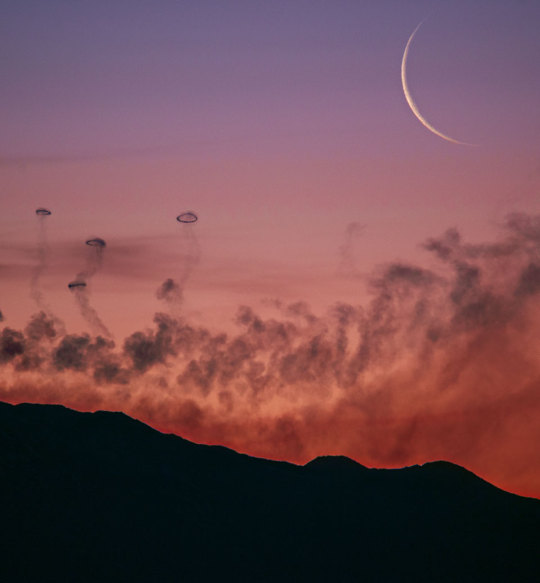
2024 April 22
Moon and Smoke Rings from Mt. Etna
Image Credit & Copyright: Dario Giannobile
Explanation: Yes, but can your volcano do this? To the surprise of some, Mt. Etna emits, on occasion, smoke rings. Technically known as vortex rings, the walls of the volcano slightly slow the outside of emitted smoke puffs, causing the inside gas to move faster. A circle of low pressure develops so that the emitted puff of volcanic gas and ash loops around in a ring, a familiar geometric structure that can be surprisingly stable as it rises. Smoke rings are quite rare and need a coincidence of the right geometry of the vent, the right speed of ejected smoke, and the relative calmness of the outside atmosphere. In the featured image taken about two weeks ago from Gangi, Sicily, Italy, multiple volcanic smoke rings are visible. The scene is shaded by the red light of a dawn Sun, while a crescent Moon is visible in the background.
∞ Source: apod.nasa.gov/apod/ap240422.html
104 notes
·
View notes
Video
youtube
2024 April 21
Perijove 16: Passing Jupiter
Video Credit & License: NASA, Juno, SwRI, MSSS, Gerald Eichstadt;
Music: The Planets, IV. Jupiter (Gustav Holst); USAF Heritage of America Band (via Wikipedia)
Explanation: Watch Juno zoom past Jupiter. NASA’s robotic spacecraft Juno is continuing on its now month-long, highly-elongated orbits around our Solar System’s largest planet. The featured video is from perijove 16, the sixteenth time that Juno passed near Jupiter since it arrived in mid-2016. Each perijove passes near a slightly different part of Jupiter’s cloud tops. This color-enhanced video has been digitally composed from 21 JunoCam still images, resulting in a 125-fold time-lapse. The video begins with Jupiter rising as Juno approaches from the north. As Juno reaches its closest view – from about 3,500 kilometers over Jupiter’s cloud tops – the spacecraft captures the great planet in tremendous detail. Juno passes light zones and dark belts of clouds that circle the planet, as well as numerous swirling circular storms, many of which are larger than hurricanes on Earth. As Juno moves away, the remarkable dolphin-shaped cloud is visible. After the perijove, Jupiter recedes into the distance, now displaying the unusual clouds that appear over Jupiter’s south. To get desired science data, Juno swoops so close to Jupiter that its instruments are exposed to very high levels of radiation.
∞ Source: apod.nasa.gov/apod/ap240421.html
67 notes
·
View notes
Photo
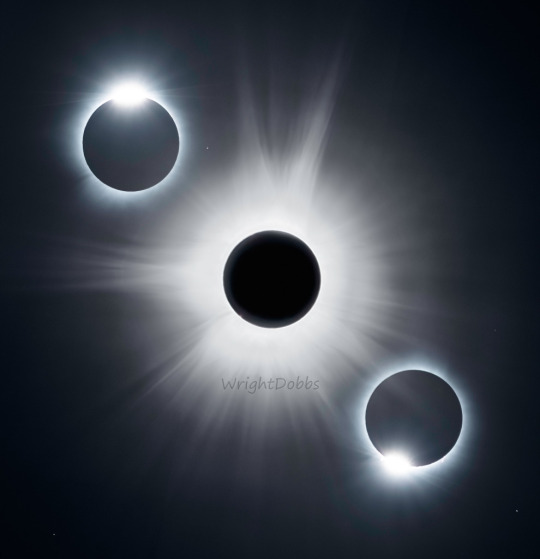
2024 April 20
Diamonds in the Sky
Image Credit & Copyright: Wright Dobbs
Explanation: When the dark shadow of the Moon raced across North America on April 8, sky watchers along the shadow’s narrow central path were treated to a total solar eclipse. During the New Moon’s shadow play diamonds glistened twice in the eclipse-darkened skies. The transient celestial jewels appeared immediately before and after the total eclipse phase. That’s when the rays of a vanishing and then emerging sliver of solar disk are just visible behind the silhouetted Moon’s edge, creating the appearance of a shiny diamond set in a dark ring. This dramatic timelapse composite from north-central Arkansas captures both diamond ring moments of this total solar eclipse. The diamond rings are separated by the ethereal beauty of the solar corona visible during totality.
∞ Source: apod.nasa.gov/apod/ap240420.html
96 notes
·
View notes
Photo

2024 April 19
The Great Carina Nebula
Image Credit & Copyright: Demison Lopes
Explanation: A jewel of the southern sky, the Great Carina Nebula is more modestly known as NGC 3372. One of our Galaxy’s largest star forming regions, it spans over 300 light-years. Like the smaller, more northerly Great Orion Nebula, the Carina Nebula is easily visible to the unaided eye. But at a distance of 7,500 light-years it lies some 5 times farther away. This stunning telescopic view reveals remarkable details of the region’s glowing filaments of interstellar gas and obscuring cosmic dust clouds. The Carina Nebula is home to young, extremely massive stars, including the still enigmatic variable Eta Carinae, a star with well over 100 times the mass of the Sun. Eta Carinae is the bright star above the central dark notch in this field and left of the dusty Keyhole Nebula (NGC 3324).
∞ Source: apod.nasa.gov/apod/ap240419.html
98 notes
·
View notes
Photo

2024 April 18
Facing NGC 1232
Image Credit & Copyright: Neil Corke
Explanation: From our vantage point in the Milky Way Galaxy, we see NGC 1232 face-on. Nearly 200,000 light-years across, the big, beautiful spiral galaxy is located some 47 million light-years away in the flowing southern constellation of Eridanus. This sharp, multi-color, telescopic image of NGC 1232 includes remarkable details of the distant island universe. From the core outward, the galaxy’s colors change from the yellowish light of old stars in the center to young blue star clusters and reddish star forming regions along the grand, sweeping spiral arms. NGC 1232’s apparent, small, barred-spiral companion galaxy is cataloged as NGC 1232A. Distance estimates place it much farther though, around 300 million light-years away, and unlikely to be interacting with NGC 1232. Of course, the prominent bright star with the spiky appearance is much closer than NGC 1232 and lies well within our own Milky Way.
∞ Source: apod.nasa.gov/apod/ap240418.html
102 notes
·
View notes

